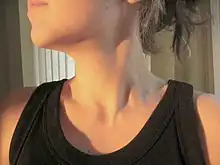頸
See also: 颈
| ||||||||
Translingual
| Traditional | 頸 |
|---|---|
| Shinjitai (extended) |
頚 |
| Simplified | 颈 |
Han character
頸 (Kangxi radical 181, 頁+7, 16 strokes, cangjie input 一一一月金 (MMMBC), four-corner 11186, composition ⿰巠頁)
References
- KangXi: page 1405, character 14
- Dai Kanwa Jiten: character 43515
- Dae Jaweon: page 1922, character 19
- Hanyu Da Zidian (first edition): volume 7, page 4373, character 7
- Unihan data for U+9838
Chinese
Glyph origin
Characters in the same phonetic series (巠) (Zhengzhang, 2003)
Phono-semantic compound (形聲, OC *keŋʔ, *ɡeŋ) : phonetic 巠 (OC *keːŋ) + semantic 頁 (“body part”).
Pronunciation

頸
Definitions
頸
Synonyms
Dialectal synonyms of 脖子 (“neck”) [map]
Compounds
Etymology 2
| trad. | 頸 | |
|---|---|---|
| simp. | 颈 | |
Usually considered to be the colloquial reading of etymology 1. Wang (2016) considers the semantic narrowing from “neck” to “nape” in the limited context of 脖_子 to be implausible.
Pronunciation
Pronunciation
Japanese
Korean
Etymology
From Middle Chinese 頸 (MC kiᴇŋX).
| Historical Readings | ||
|---|---|---|
| Dongguk Jeongun Reading | ||
| Dongguk Jeongun, 1448 | 겨ᇰ〯 (Yale: kyěng) | |
| Middle Korean | ||
| Text | Eumhun | |
| Gloss (hun) | Reading | |
| Hunmong Jahoe, 1527 | 목 (Yale: mwòk) | 겨ᇰ〯 (Yale: kyěng) |
Pronunciation
- (SK Standard/Seoul) IPA(key): [kjʌ̹ŋ]
- Phonetic hangul: [경]
Vietnamese
This article is issued from Wiktionary. The text is licensed under Creative Commons - Attribution - Sharealike. Additional terms may apply for the media files.